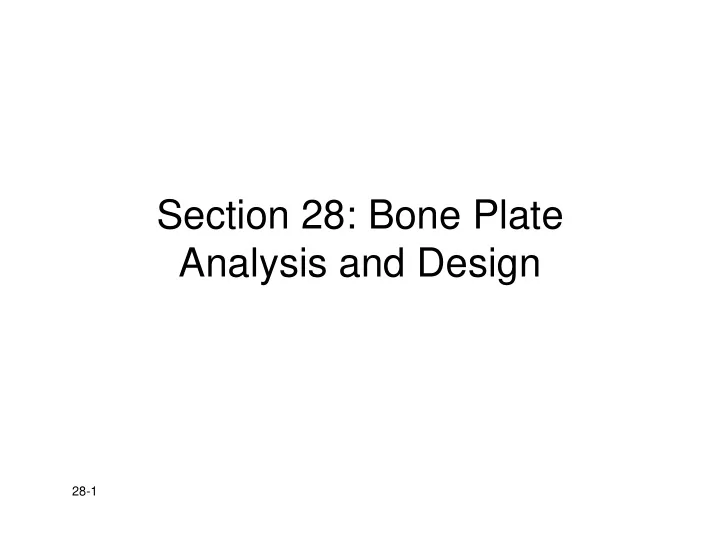

Section 28: Bone Plate Analysis and Design 28-1
Biomechanics of Bone Fx • Weakest in Tension, Strongest in Compression • Pure Bending � T Transverse Fx F • Torsion � Spiral Fx • Shear � Oblique Fx Fx • Butterfly due to Bend + Shear Bend + Shear 28-2 From: Justice
Screw fixation Screw fixation • Rotary forces � compression between Rotary forces � compression between objects (inclined plane on spiral pulls object toward head) object toward head) • Four part construction: head, shaft, thread tip thread, tip • Thread defined by root diameter, thread di diameter, pitch t it h 28-3 From: Justice
Screws Screws • Larger core diameter has Larger core diameter has higher resistance to fatigue & shear failure – 4th power of the diameter • Pullout strength (maximum force screw can support along its axis) – outer diameter, length of t di t l th f engagement, shear strength/density of bone g y 28-4 From: Justice
Screw fixation From: Justice 28-5
Interfragmentary compression screw • Lag screw can convert torque forces to a Lag screw can convert torque forces to a compressive force • Screw should be perpendicular to fracture p p preventing sliding of fragments when compressed • Gliding hole => cortex under screw head drilled to thread diameter • Thread hole => opposite glide hole; drilled to the core diameter of screw 28-6 From: Justice
From: Justice 28-7
Interfragmentary compression screw • This alone is well suited for avulsion, , epiphyseal, metaphyseal and intraarticular fractures- absolute stability, no callus 28-8 From: Justice
Plate and screw fixation Plate and screw fixation • For transverse or short oblique fx screws For transverse or short oblique fx, screws must be combined with other internal fixation fixation • Principle based on converting tension force to compression force force to compression force • Accomplished by placing plate on tension or convex side of bone id f b 28-9 From: Justice
Plate and screw fixation Plate and screw fixation 28-10 From: Justice
Plate and screw fixation Plate and screw fixation • Plates offer benefits of anatomic Plates offer benefits of anatomic reduction and stability for early motion, but must be protected from early weight p y g bearing. • Ideally 3-4 screws on each side of y fracture • Prebending the plate to increase g p compression 28-11 From: Justice
Biomechanics of Plate Fixation Biomechanics of Plate Fixation • Function of the plate Function of the plate – Internal splint – Compression p • “The bone protects the plate” 28-12 From: Le
Biomechanics of Plate Fixation Biomechanics of Plate Fixation Applied Load • Fracture Gap /Comminution Fracture Gap /Comminution – Allows bending of plate with applied loads – Fatigue failure Gap Bone Plate Plate 28-13 From: Le
Plates & Bending failure failure • Leaving gap opposite plate makes it a fulcrum makes it a fulcrum • increased stress at holes • avoid holes over fracture avoid holes over fracture sites • greater the span between greater the span between screws – less stiff – more bending 28-14 From: Justice
Biomechanics of Plate Fixation Biomechanics of Plate Fixation Applied Load • Bone-Screw-Plate Bone Screw Plate Relationship – Bone via compression – Plate via bone-plate friction – Screw via resistance S i i t to bending and pull out. 28-15 From: Le
Biomechanics of Plate Fixation Biomechanics of Plate Fixation • Plates: – Bending stiffness g Height g proportional to the (h) Base (b) thickness (h) of the plate to the 3 rd 3 d th l t t th I= bh 3 /12 power. 28-16 From: Le
Biomechanics of Plate Fixation Biomechanics of Plate Fixation • The screws closest to The screws closest to the fracture see the most forces. • The construct rigidity decreases as the distance between the innermost screws increases increases. Screw Axial Force 28-17 From: Le
Biomechanics of Plate Fixation Biomechanics of Plate Fixation • Number of screws (cortices) Number of screws (cortices) recommended on each side of the fracture: Forearm 3 (5-6) Humerus Humerus 3 4 3-4 (6-8) (6 8) Tibia 4 (7-8) Femur Femur 4-5 4 5 (8) (8) 28-18 From: Le
Prebending From: Justice 28-19
• Dynamic Compression Compression 28-20 From: Justice
From: Justice • Tension Band Plate 28-21
Recommend
More recommend